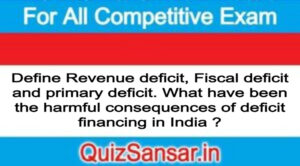
Define Revenue deficit, Fiscal deficit and primary deficit. What have been the harmful consequences of deficit financing in India ?
Define Revenue deficit, Fiscal deficit and primary deficit. What have been the harmful consequences of deficit financing in India ?
Or
Define Revenue deficit, fiscal deficit and primary deficit with their importance.
Ans.
Revenue Deficit
Revenue deficit is excess of total revenue expenditure of the government over its total revenue receipts. It is related to only revenue expenditure and revenue receipts of the government. Alternatively, the shortfall of total revenue receipts compared to total revenue expenditure is defined as revenue deficit.
Revenue deficit signifies that government’s own earning is insufficient to meet normal functioning of government departments and provision of services. Revenue deficit results in borrowing. Simply put, when government spends more than what it collects by way of revenue, it incurs revenue deficit. Mind, revenue deficit includes only such transactions which affect current income and expenditure of the government. Put in symbols-
Revenue deficit = Total Revenue expenditure – Total Revenue receipts For instance, revenue deficit in government budget estimates for the year 2012-13 is Rs 3,50,424 crore (= Revenue expenditure Rs 12,86,109 crore – Revenue receipts 9,35,685 crore) vide summary of the budget in Section 9.18. It reflects government’s failure to meet its revenue expenditure fully from its revenue receipts.
The deficit is to be met from capital receipts, i.e., through borrowing and sale of its assets. Given the same level of fiscal deficit, a higher revenue deficit is worse than lower one because it implies a higher repayment burden in future not matched by benefits via investment.
Remedial measures : A high revenue deficit warns the government either to curtail its expenditure or increase its tax and non-tax receipts. Thus, main remedies are-(i) Government should raise rate of taxes especially on rich people and any new taxes where possible, (ii) Government should try to reduce its expenditure and avoid unnecessary expenditure.
Implications: Simply put, revenue deficit means spending beyond the means. This results in borrowing. Loans are paid back with interest. This increases revenue expenditure leading to greater revenue deficit. Main implications are-
(i) Reduction of assets: Revenue deficit indicates dissaving on government account because government has to make up the uncovered gap by drawing upon capital receipts either through borrowing or through sale of its assets (disinvestment).
(ii) Inflationary situation : Since borrowed funds from capital account are used to meet generally consumption expenditure of the government, it leads to inflationary situation in the economy with all its ills. Thus, revenue deficit may result either in increasing government liabilities or in reduction of government assets. Remember, revenue deficit implies a repatnent burden in future without the benefit arising from investment.
(iii) More revenue deficit : Large borrowings to meet revenue deficit will increase debt burden due to repayment liability and interest payments. This may lead to larger and larger revenue deficits in future.
1. Fiscal Deficit : Fiscal deficit is defined as excess of total budget expenditure over total budget receipts excluding borrowings during a fiscal year. In simple words, it is amount of borrowing the government has to resort to meet its expenses. A large deficit means a large amount of borrowing. Fiscal deficit is a measure of how much the government needs borrow from the market to meet its expenditure when its resources are inadequate. In the form of an equation-
Fiscal deficit = Total expenditure – Total receipts excluding borrowing = Borrowing
If we add borrowing in total receipts, fiscal deficit is zero. Clearly, fiscal deficit gives borrowing requirements of the government. Let it be noted that safe limit of fiscal deficit is considered to be 5% of GDR Again, borrowing includes not only accumulated debt i.e. amount of loan but also interest on debt, i.e., interest on loan. If we deduct interest payment on debt from borrowing, the balance is called primary deficit.
Fiscal deficit = Total Expenditure-Revenue receipts – Capital receipts excluding borrowing
A little reflection will show that fiscal deficit is, in fact, equal to borrowings. Thus, fiscal deficit gives the borrowing requirement of the government.
Importance: Fiscal deficit shows the borrowing requirements of the government during the budget year. Greater fiscal deficit implies greater borrowing by the government. The extent of fiscal deficit indicates the amount of expenditure for which the government has to borrow money. For example, fiscal deficit in government budget estimates for 2012-13 is Rs 5, 13,590 crore (-14, 90,925 (9,35,685+11,650+30,000) vide summary of budget in Section 9.18\. It means about 18% of expenditure is to be met by borrowing.
Implications :
(i) Debt traps: Fiscal deficit is financed by borrowing. And borrowing creates problem of not only (a) payment of interest but also of (b) repayment of loans. As the government borrowing increases, its liability in future to repay loan amount alongwith interest thereon also increases. Payment of interest increases revenue expenditure leading to higher revenue deficit. Ultimately, government may be compelled to borrow to finance even interest payment leading to emergence of a vicious circle and debt trap.
(ii) Wasteful expenditure: High fiscal deficit generally leads to wasteful and unnecessary expenditure by the government. It can create inflationary pressure in the economy.
(iii) Inflationary pressure : As government borrows from RBI which meets this demand by printing of more currency notes (called deficit financing), it results in circulation of more money. This may cause inflationary pressure in the economy.
(iv) Partial use: The entire amount of fiscal deficit, i.e., borrowing is not available for growth and development of economy because a part of it is used for interest payment. Only primary deficit (fiscal deficit-interest payment) is available for financing expenditure.
(v) Retards future growth: Borrowing is in fact financial burden on future generation to pay loan and interest amount which retards growth of economy.
Measures to reduce fiscal deficit
(a) Measures to reduce public expenditure are:
(1) A drastic reduction in expenditure on major subsidies.
(ii) Reduction in expenditure on bonus, LTC, leaves encashment, etc.
(iii) Austerity steps to curtail non-plan expenditure.
(b) Measures to increase revenue are:
(i). Tax base should be broadened and concessions and reduction in taxes should be curtailed.
(ii) Tax evasion should be effectively checked.
(iii) More emphasis on direct taxes to increase revenue.
(iv) Restructuring and sale of shares in public sector units.
2. Primary Deficit : Primary deficit is defined as fiscal deficit of current year minus interest payments on previous borrowings. In other words whereas fiscal deficit indicates borrowing requirement inclusive of interest payment, primary deficit indicates borrowing requirement exclusive of interest payment (i.e., amount of loan).
We have seen that borrowing requirement of the government includes not only accumulated debt, but also interest payment on debt. If we deduct ‘interest payment on debt’ from borrowing, the balance is called primary deficit.
It shows how much government borrowing is going to meet expenses other than Interest payments. Thus, zero primary deficits means that government has to resort to borrowing only to make interest payments. To know the amount of borrowing on account of current expenditure over revenue, we need to calculate primary deficit. Thus, primary deficit is equal to fiscal deficit less interest payments.
Symbolically:
Primary deficit = Fiscal deficit – Interest payments
For instance, primary deficit in Government budget estimates lor the year 2012-13 amounted to Rs 1,93,831 crore (= Fiscal deficit 5,13,590-interest payment 3,19,759) vide budget summary in section 9.18\.
Importance : Fiscal deficit reflects the borrowing requirements of the government for financing the expenditure inclusive of interest payments. As against it, primary deficit shows the borrowing requirements of the government including interest payment for meeting expenditure. Thus, if primary deficit is zero, then fiscal deficit is equal to interest payment. Then it is not adding to the existing loan.
Thus, primary deficit is a narrower concept and a part of fiscal deficit because the latter also includes interest payment. It is generally used as a basic measure of fiscal irresponsibility. The difference between fiscal deficit and primary deficit reflects the amount of interest payments on public debt incurred in the past. Thus, a lower or zero primary deficits means that while its interest commitments on earlier loans have forced the government to borrow, it has realised the need to tighten its belt.
The evil effects of deficit financing are: Firstly, it is a self-defeating method of financing as it always leads to inflationary rise in prices. Unless inflation is controlled, the benefits of deficit-induced inflation would not fructify. And, underdeveloped countries- being inflation-sensitive countries-get exposed to the dangers of inflation.
Secondly, deficit financing-led inflation helps producing classes and businessmen to flourish. But fixed-income earners suffer during inflation. This widens the distance between the two classes. In other words, income inequality increases.
Thirdly, another important drawback of deficit financing is that it distorts investment pattern. Higher profit motive induces investors to invest their resources in quick profit-yielding industries. Of course, investment in such industries is not desirable in the interest of a country’s economic development.
Fourthly, deficit financing may not yield good result in the creation of employment opportunities. Creation of additional employment is usually hampered in backward countries due to lack of raw materials and machineries even if adequate finance is available.
Fifthly, as purchasing power of money declines consequent upon inflationary price rise, a country experiences flight of capital abroad for safe return thereby leading to a scarcity of capital.
Finally, this inflationary method of financing leads to a larger volume of deficit in a country’s balance of payments. Following inflationary rise in prices, export declines while import bill rises, and resources get transferred from export industries to import-competing industries.






